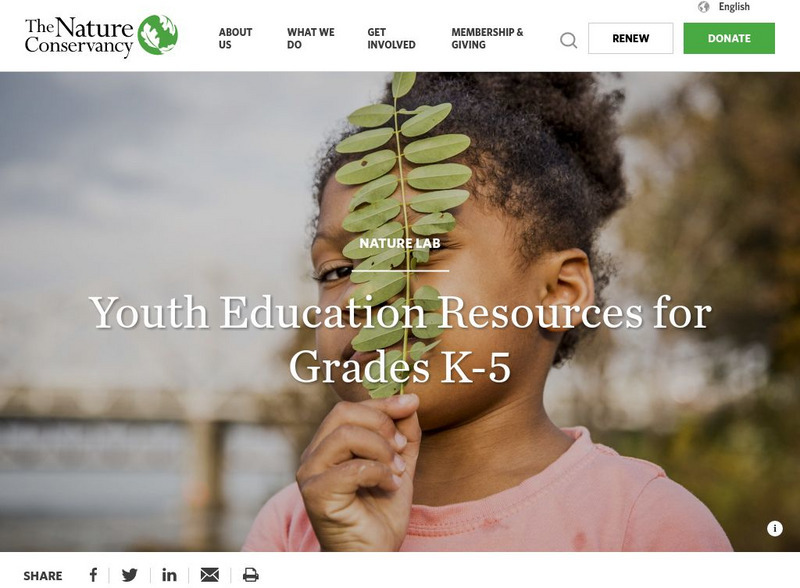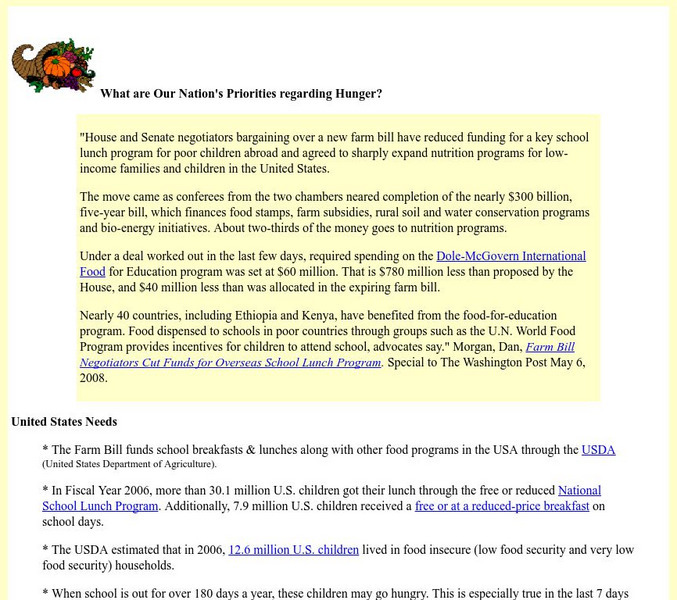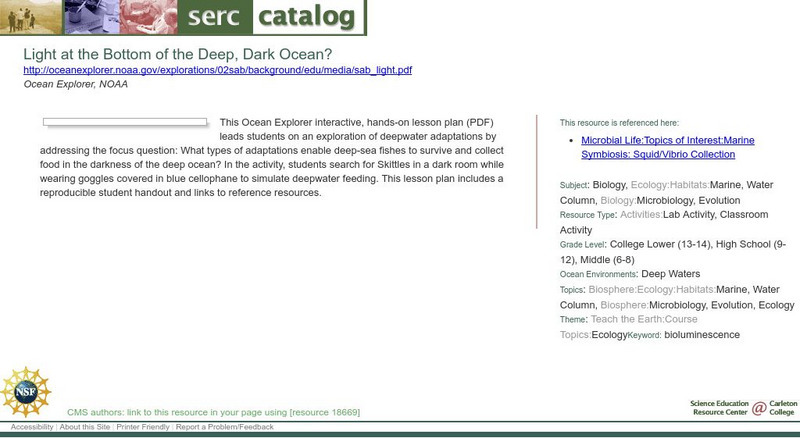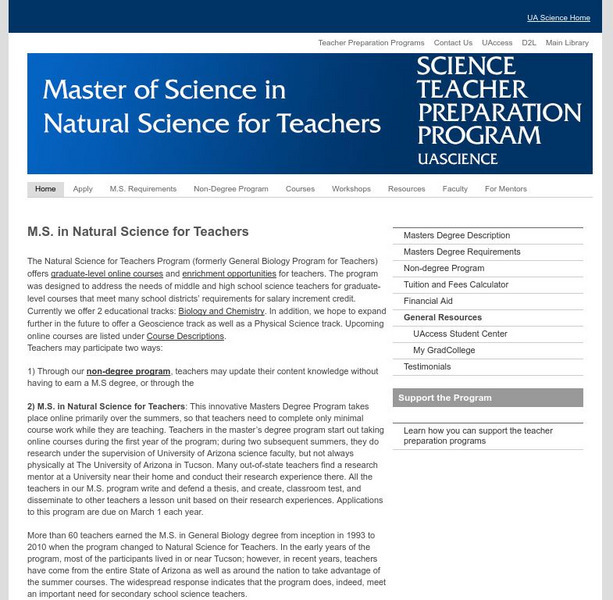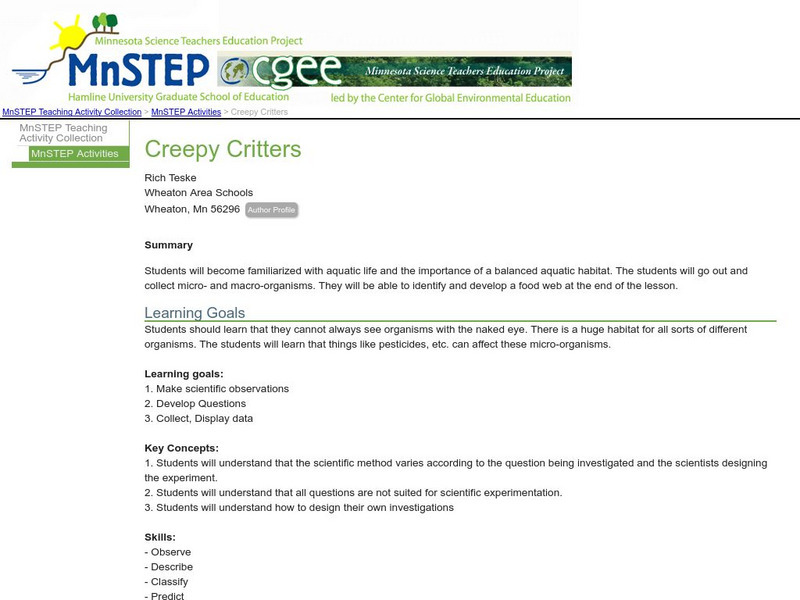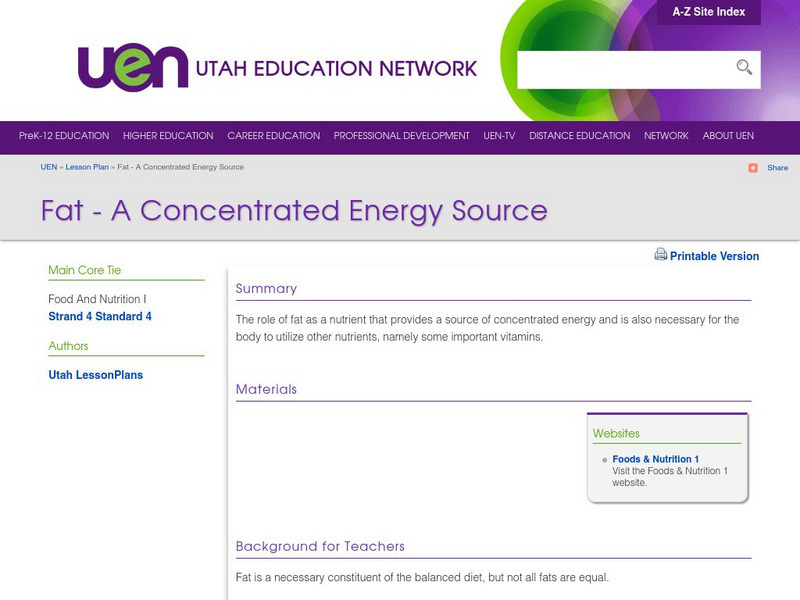TeachEngineering
Teach Engineering: Food Chains and Food Webs
This instructional activity, supported by the provided power point lecture (LESSON 1 and 2 Ecology Lecture Supplement ), introduces students to the concepts of food chains and food webs. Through its use, students learn the difference...
Better Lesson
Better Lesson: Reading Tables: What Breakfast Food Is Your Favorite?
In this lesson, 2nd graders will understand that tables help us organize information clearly.
Science Education Resource Center at Carleton College
Serc: Investigating Ecosystems:determining Feeding Relationships Among Organisms
In this lab, students will complete a field study about feeding relationships between organisms and present their findings in a food web as well as in a written narrative.
Science Education Resource Center at Carleton College
Serc: Life in Extreme Environments: Who Is on Top in the Food Chain?
In this lesson, students will design experiments to gain some understanding of the feeding rates of Rotifers and/or Tardigrades. They will use organisms collected locally or provided by the teacher to explore differences between their...
PBS
Now With Bill Moyers: Genetically Modified Foods
Learn about genetically-engineered foods, then research and report how genetic engineering is done. Investigate the pros and cons related to genetically engineered crops, and express one's own feelings on the topic.
Other
My Science Box: Food Webs
In this lesson, students will choose an organism of their choice and research its life cycle, food chain, diet, and habitat, then predict how habitat change might affect the organisms living within it.
Other
My Science Box: Food Chains
Students will use a card sorting activity to construct a food chain and identify the role of organisms within that chain. The cards represent different individuals in an ecosystem and will help students begin to understand the concepts...
Utah Education Network
Uen: Trb 4:5 Investigation 3 Web of Life
Understand environments and how organisms adapt to their environment.
Nature Conservancy
The Nature Conservancy: Gardens Activity Guide: Soil
For this lesson students conduct a soil analysis to understand soil types and explore the relationship between the garden and healthy, fertile soil. Soil is a natural resource that is crucial to life on Earth and when managed properly,...
Smithsonian Institution
Environmental Research Center: Forces of Change: Listening to the Prairie
A large collection of lessons on prairie agriculture for Pre-K to Grade 12, organized into grade level groups. They cover such topics as foods that come from agriculture, animal farming, soils, and environmental issues. These lessons on...
Cynthia J. O'Hora
Mrs. O's House: What Are Our Nation's Priorities Regarding Hunger?
Identify government funded food programs in the community. Students will consider facts about monies funded to support food for children in the United States and evaluate the ethics in organizations that give prizes to support feeding...
US Geological Survey
Lake Pontchartrain Basin Foundation: Ecosystems in Delicate Balance
Learning activities to investigate how organisms interact in a functioning ecosystem. Students will explore the role organisms play in food chains and preserving biodiversity in ecosystems. Lake Pontchartrain Basin ecosystem is featured...
ArtsNow
Arts Now Learning: Using Tableau and Role Drama to Examine the Ecosystem [Pdf]
In this lesson plan, 4th graders use tableaux to dramatize their roles in the food chain of an ecosystem. Next, they write in role arguing why they are important to the ecosystem. This is followed by a debate in the format of a Character...
Science Education Resource Center at Carleton College
Serc: Light at the Bottom of the Deep, Dark Ocean?
What types of adaptations enable deep-sea fishes to survive and collect food in the darkness of the deep ocean? Interactive, hands-on lesson plan takes students on an exploration of deepwater adaptations by searching for Skittles in a...
University of Arizona
Univ. Of Az: Spiders: An Organism for Teaching Biology
Students capture spiders and then conduct various experiments to identify their spider, analyze its feeding rate, and discover its effect on populations of insects. Includes directions for student activities and teaching tips.
National Institute of Educational Technologies and Teacher Training (Spain)
Ministerio De Educacion: La Dinamica De Los Ecosistemas
This unit shows how ecosystems change over time and how matter and energy, which are essential to its operation, are transformed and passed from one living thing to another forming, in some cases, authentic cycles. It contains 19...
BioEd Online
Bio Ed Online: Why Circulate?
In this lesson plan students will observe the dispersion of a drop of food coloring in water, draw conclusions about the movement of dissolved substances, and develop explanations about the importance of organisms' internal transport...
BioEd Online
Bio Ed Online: Muscles and Bones
Do you know which foods have lots of calcium for your bones? How do your bones and muscles work together? What are you doing to keep your muscles strong? Students are exposed to 10 activities that will help them address the...
Science Education Resource Center at Carleton College
Serc: Creepy Critters
Students learn about aquatic life and the importance of a balanced aquatic habitat by collecting micro- and macro-organisms. By the end of the instructional activity, they will be able to identify and develop a pond food web.
BioEd Online
Bio Ed Online: Digestion
In this lesson students learn about digestion and proteins by observing the action of meat tenderizer on luncheon meat. Student sheets are provided in English and in Spanish.
Other
Ontario Council for Technology Education: Model Greenhouse Construction [Pdf]
Learners will design and construct a scale model of a greenhouse using the design process. Each student designs and builds a device that will act as a greenhouse in which to propagate plants from seed, that allows for easy access, and...
Utah Education Network
Uen: Fat a Concentrated Energy Source
Through these lesson plans, students explore and discuss the role of dietary fat as an important energy source. In addition to providing detailed instructions for teachers, this website includes all the handouts and charts needed to...
PBS
Pbs Teachers: Crisis in Sudan: Responding to Medical Emergencies
Investigate the medical nature of the humanitarian crisis in the Darfur region of Sudan. Describe the nature of cholera, malaria, hepatitis E, Ebola and malnutrition, which have been of major concern to humanitarian aid personnel in this...
Discovery Education
Discovery Education: Africa Its People and Places
A very comprehensive lesson plan that helps prepare students for a trip to Africa taking into consideration climate, customs, geography, and language.
Other popular searches
- Con Pair Organic Foods
- Organic Foods Taste
- Non Organic Foods
- Com Pair Organic Foods
- California Organic Foods
- Compair Organic Foods
- Conpair Organic Foods
- Organic Foods Lesson Plan





